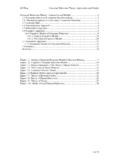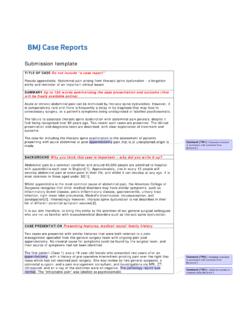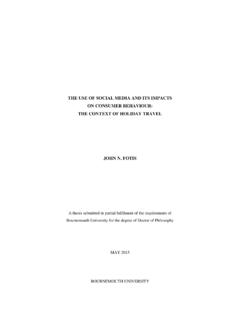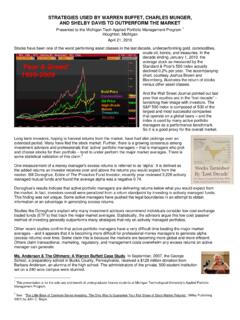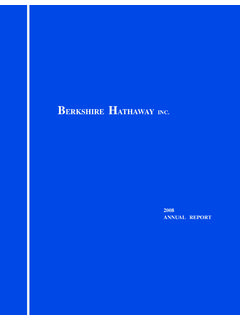Transcription of Chapter 13 Reputation Management; Corporate …
1 Chapter 13 Reputation management : Corporate image and CommunicationTom Watson1 and Philip J. Kitchen21 [Bournemouth University2 [Hull University Business School]Introduction Never do anything you wouldn t want to be caught dead doing. Actor John Carradine advisinghis actor son, was, is, and always will be of immense importance to organisations, whethercommercial, governmental or not-for-profit. To reach their goals, stay competitive and prosper,good Reputation paves the organisational path to acceptance and approval by stakeholders. Evenorganisations operating in difficult ethical environments perhaps self-created need to sustain apositive Reputation where and Druckenmiller argue that organisations increasingly recognize the importance ofcorporate Reputation to achieve business goals and stay competitive (2004, p.)]
2 368). While thereare many recent examples of organisations whose leadership and business practice behaviourshave destroyed their reputations, such as Enron, Arthur Andersen, Tyco and WorldCom, thepositive case for Reputation is that it has fostered continued expansion of old stagers like Johnson& Johnson and Philips, and innovators such as Cisco Systems, who top recent rankings of themost respected organisations in the US and is evident is that Reputation does not occur by chance. It relates to leadership, managementand organisational operations; the quality of products and services; and crucially relationshipswith stakeholders. It is also connected to communication activities and feedback Chapter will consider the definitions and nature of Reputation and its management , bestpractice and evaluation.
3 It will also discuss the boundaries between branding, image ObjectivesAt the end of this Chapter , the reader should be able to: Prepare his or her own working definition of Reputation management Identify best practices in Reputation management Understand the transnational nature of Reputation and its management Prepare strategies to plan, research and evaluate Reputation in a Corporate entityWhat Is Reputation ?Dictionary definitions of Reputation , while normally focused on individuals, give strongindications of the elements that are relevant to organisations. Examples include: The beliefs or opinions that are generally held about someone or something. 2 A widespreadbelief that someone or something has a particular characteristic (Compact Oxford English Dictionary, 2009)Overall quality or character as seen or judged by people in general.
4 A place in publicesteem or regard : good name.(Merriam-Webster)In the Corporate world, Reputation is seen as a major element of an organisation s provenancealongside and included in financial performance and innovation. The academic-practitioner teamof Paul Argenti and Bob Druckenmiller suggest that it is a collective representation of multipleconstituencies images of a company built up over time (Argenti and Druckenmiller, 2004, ). It is also linked to the organisation s identity, performance and the way others respond to elements to note are that the Reputation is a collective representation of images andperceptions, not a self-promoted message . It involves relationships with all stakeholders( constituencies ) and it is gained, maintained and enhanced or detracted from over and White s research amongst UK CEOs has found similar characteristics:It s the role of public relations to make sure that the organisation is getting credit for thegood it does.
5 Great reputations are built on doing this consistently over a period of time inwhich a track record of delivering on promises and engendering trust is evident toeveryone. All members of an organisation have a contribution to make to building andsustaining Reputation .(Murray and White, 2004, p. 10)The elements of promoted yet sustainable image and performance are again identified, but anholistic factor all members of an organisation is added. Later in this Chapter , the role ofCEOs in defining and driving Reputation is discussed. However, it is broadly accepted that goodreputation is unsustainable without internal organisational support. Neglect of Reputation bymeans of apathy, indifference or ineffective communication is leaving a key communication to thevagaries of other market and White also point to relationship management as being at the heart of creating,enhancing and retaining a good Reputation (2004, p.)
6 10). They see strong communicationperformance by organisational leaders and effective feedback mechanisms from stakeholders asessential for articulating relevant messages and making better informed decisions that retain thesupport of a Good Corporate ReputationUK public relations industry leader Adrian Wheeler, taking cognisance of market research, thatfound 28 per cent of people do trust business leaders to tell the truth (meaning 72 per cent do not),has proposed six components of good Corporate Reputation . He also comments that corporatereputation is a slow-build proposition (Wheeler, 2001, p. 8).His six Reputation components are: Be obsessed with your product or service: Nothing comes close to superior productquality in influencing the way people feel about your organisation.
7 Deserve confidence: Lead from the front and engender trust from employees andcustomers. Be available: Don t hide behind a wall of middle managers and advisers. Buildrelationships with customers, employees and suppliers. Admit mistakes: If mistakes are made, admit them and respond rapidly. Engage people s interest: For CEOs and companies, taking up a public cause separatesyou or your company from the rest. Get all staff involved. Have something to say: Most people think business is boring, so make it interesting andhuman. CEOs can use their own and the business s personality to communicate withimpact and colour.(Wheeler, 2001, pp. 9 10)Brand, identity and reputationThese three terms are sometimes used interchangeably brand and image ; image and Riel and Berens say, Corporate identity can be defined as a company s self-presentation, thatis, the managed cues or signals that an organisation offers about itself to stakeholders (2001, ).
8 It also defined by Argenti and Druckenmiller as consisting of a company s definingattributes, such as its people, products, and services (2004, p. 369). Van Riel and Berens alsopoint to the Corporate symbolism as part of the identity, which includes logos, house style, staffuniforms, etc. (2001, p. 45). The transmitted Corporate identity is received by stakeholders asimage, a reflection of the organization s identity and its Corporate brand (Argenti andDruckenmiller, 2004, p. 45). This image or set of images thus contributes to the Reputation of Corporate brand is also an expression of the organisation s presentation to others. Argenti andDruckenmiller define it as: a brand that spans an entire company (which can have disparateunderlying product brands); and.
9 Conveys expectations of what the company will deliver interms of products, services, and customer experience (2004, p. 369).Argenti and Druckenmiller (2004, p. 369) proposed a taxonomy of questions which simplifies thedifferences between these terms.|Term |Question ||Identity |Who are you? || Corporate brand |Who do you say you are and || |want to be? || image |What do stakeholders think of || |whom you are and who you tell || |them you are? || Reputation |What do all the stakeholders || |think of whom you tell them || |you are and what have you || |done?
10 |As can be seen, the primary (and important) difference between image and Reputation is thatreputation is a two-way relationship with stakeholders and thus open to managerial Reputation Be Managed?The question of the validity of the term Reputation management is also at the core of this the new field of reputations management , there is academic research and a body of knowledge;a specialist academic journal, Corporate Reputation Review; as well, many public relationsconsultancies are rebranding as Reputation managers (Hutton et al., 2001, pp. 247 248). There isalso an assumption that all organisations have a Reputation , be it good, neutral or bad. But, howwell can this be managed, controlled or directed?
